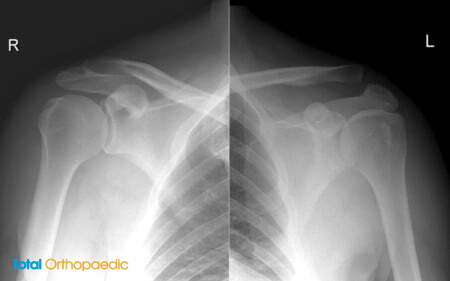
What is Acromioclavicular Joint Injury?
Acromioclavicular joint injury, or shoulder separation, is characterised by joint pain when raising your hand. The acromioclavicular joint (ACJ), also known as the AC joint, is located between the clavicle (collarbone) and the acromion process of the scapula (shoulder blade).
AC joint pain is a fairly common injury accounting for 8-9% of all shoulder injuries.
Symptoms of ACJ Injury
The symptoms of an ACJ disruption or dislocation may include:
Pain
Bruising
Swelling
Visible lump on the top of the shoulder (in more severe cases)
Causes of ACJ Injury
ACJ disruptions are commonly caused by
- falls onto an outstretched arm,
- direct blows to the shoulder, or
- sudden twisting and jerking motions.
These incidents typically result in injury to the ligaments that hold the joint together. High energy injuries may also be associated with additional bony or nerve damage.
Acromioclavicular (AC) joint injuries are categorised into six types based on their severity and the ligaments affected:
- Type 1: A partial tear or sprain of the AC ligament, with the coracoclavicular (CC) ligament remaining intact.
- Type 2: A complete tear of the AC ligament, with little to no damage to the CC ligament.
- Type 3: Both the AC and CC ligaments are fully torn, separating the clavicle from the scapula.
- Types 4-6: These are rare but severe injuries, involving complete rupture of both ligaments and damage to surrounding muscles.
Diagnosis of ACJ Injury
The doctor will first ask questions about your injury. Then conduct a careful examination of your shoulder to rule out associated injuries or damage to the nerves and vessels near the collarbone.
Additionally, X-rays (occasionally both sides for comparison) and potentially an MRI may be necessary to identify severity of the injury.
If you suspect you have an ACJ injury, it is important to seek medical attention from an orthopaedic specialist.
Treatment of ACJ Injury

Treatment for an ACJ disruption varies depending on severity and other factors such as age, overall health, and activity level. In mild cases, non-surgical treatments such as rest, ice, pain medication, and physical therapy may be sufficient.
More severe cases may require surgical intervention such as open reduction and internal fixation (ORIF) with plates and screws to realign the joint and fix it in place. Alternatively, small buttons and sutures may also be used where appropriate. It is our preferred method if surgery is required (where suitable).
Rehabilitation
Following treatment for ACJ disruption, rehabilitation typically involves physical therapy to restore strength, function and range of motion in the shoulder joint. It is important to follow your orthopaedic specialist’s instructions for treatment and rehabilitation to ensure the best possible outcome for your ACJ injury.
If you suspect you have an ACJ injury, do make an appointment with an orthopaedic specialist at Total Orthopaedic Care & Surgery for a detailed assessment of your condition. Our expert team will be able to advise you on the best course of action and guide you through treatment to restore shoulder function as quickly and safely as possible.



